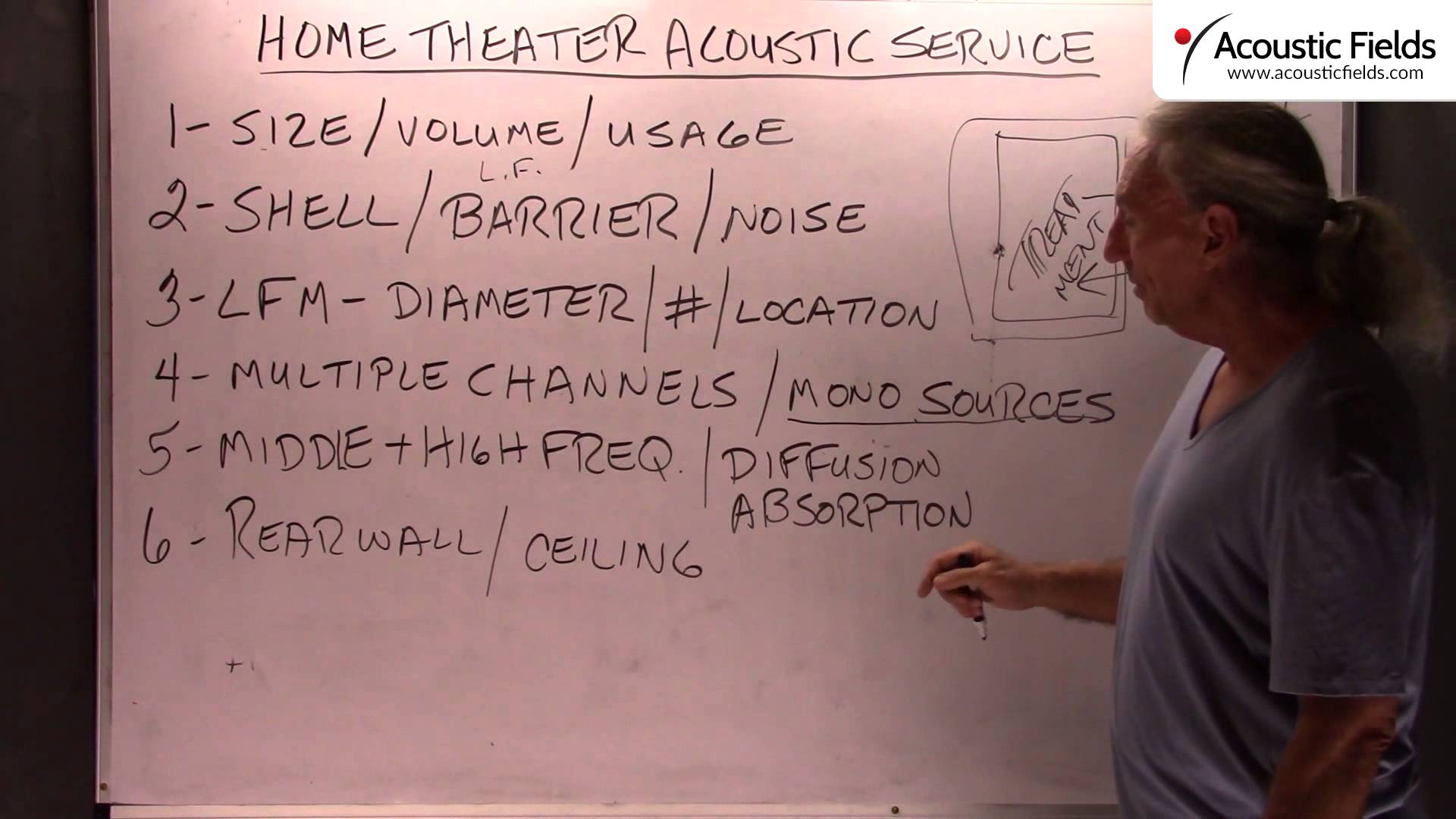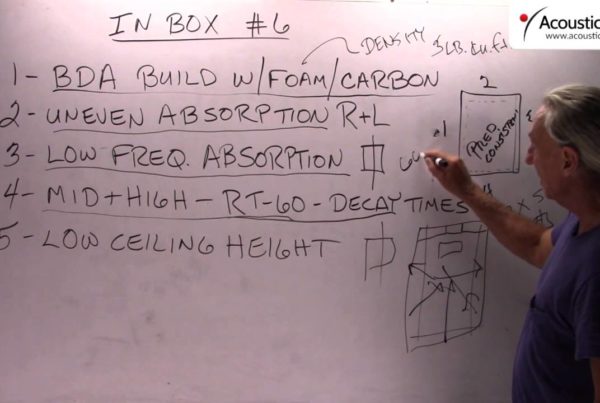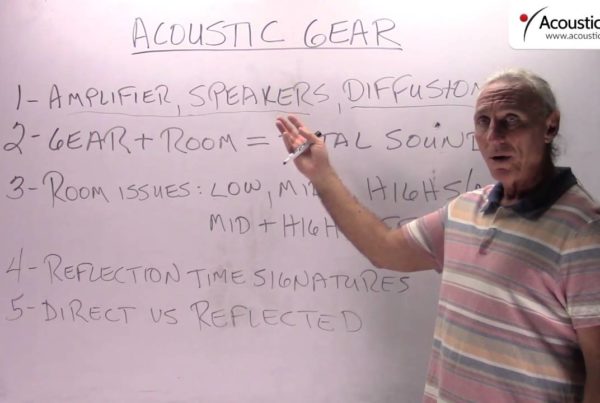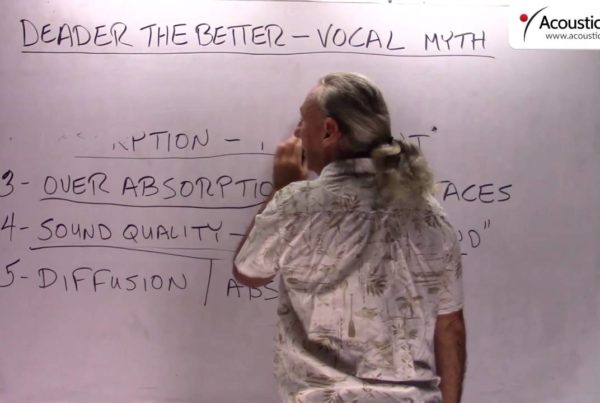Today we’re going to talk about home theater acoustic service that we offer. We don’t do a lot in home theater but we do some to help people out and we’re just going to walk through 5 or 6 different areas to kind of give you a feel for what you need to look at for this particular service.
We have size, volume and usage. This holds true for almost any room that you’re trying to do. You must match the size and the volume to what you’re doing in the room. If you have a room that’s 12 by 14 by 8 and you’re going to put 7 speakers in it, you’re in trouble from the beginning. Because you can’t manage the low frequency energy and you can’t manage all those reflections from all those mono sources. So you’ve got to define first how big the room’s going to be, what’s the associated volume because that’s all about low frequency management, and what are we doing?
So it’s home theater, so we have to be very careful in the beginning to match the size, the volume and the usage of the room together. It’ll go a long way down the road when we set up our gear, we get the room built and we set up our gear, to managing the issues that you’re going to see. And there’s always issues that need to be managed. So we’re trying to minimize those issues by getting our size volume correct in the beginning.
So we have our two rooms really, remember, kind of like a room within a room. We have our barrier or shell of the room, this is called the shell and then we have the interior which is the treatment phase. Okay? So there is two parts to a room, almost in any usage that you’re doing, there is two parts. So we have the shell – now in home theaters the big thing is obviously the amount of energy created within the room. So our goal is to build the correct shell so that all that energy doesn’t leave the room. And obviously we don’t want a lot of external noise getting in the room.
Most home theater applications are in a home by definition, so you’re working with existing structures, working with existing room sizes, so we have to beef up the barrier, we have to use correct barrier technology to isolate from the rest of the house and usually the rest of the noise from out here from the residents of the house is not that big of an issue. It’s more the energy within the room leaving and getting into other structures within the house.
So we have shell, it’s all about the barrier and the noise keeping it in. And then how many sound [inaudible 02:46] are we going to use, what’s the low frequency management technology approach that we’re going to use? If you don’t get the low end right in a home theater, everything else doesn’t really matter. It’s all going to sound horrible.
So you definitely have to get the low frequency management under control. There is all kinds of ways to do that. You can use electronic signal processing, you can use auto-phase signal electronic processing again for cancellation, you can use low frequency absorption technology within the room, it can be free-standing, built-in, so there’s a lot of things that you can do to manage it. But your biggest benefit is choosing the right size and the volume at the beginning. So that’s the whole situation there.
Where are we going to locate ourselves? Well, first, what’s the diameter? Positioning is critical, how many is critical. So we have to figure out all that in advance and plan for it. You’ve got all these multiple mono channels. You’ve got front channel, you’ve got center channel, you’ve got side channels, you’ve got rear channels and now with Dolby Atmos, you’ve got speakers everywhere.
So you have to manage all of these sources. You have to manage all of these mono sources. They’re all contributing to RT-60 times, and a lot of them are contributing to the low frequency issues that are present in your room. So all of these issues have to be managed. Side channels have to have certain distances depending on the speakers you’re using. So the radiation pattern can fill out correctly at the listening position. Rear channel speakers is the same approach. So we have to deal with that.
How do we deal with middle and high frequency issues? Well, we have our two technologies, diffusion and absorption. We like to favor on the rear wall diffusion for home theater and we like to work with a combination of absorption and diffusion on the ceiling. The goal with the ceiling treatment is to make the ceiling acoustically disappear so the room feels larger. And you can do that if you use the right combinations of absorption and diffusion.
So home theater acoustics, please choose the right size and volume for what you’re trying to do, what kind of impact you’re trying to do. Most of the home theater rooms I’m in, the audio severely lags behind the video. The video is of much higher quality than the audio. So you have to spend a little bit more time on the audio part in a home theater room.
And here’s another issue I see all the time. Make sure you match the diameter of the drivers, the number of low frequency drivers, their position – and please don’t put them on the floor – to the size and volume of the room. Okay? Multiple channels, you need multiple approaches and multiple treatments to the whole situation.
So multiple channels, multiple sources all have to be dealt with. Our middle and high frequencies, we have diffusion and absorption.
Here’s a common thing that I’ll tell you about. So we have our screen here. And then always I see the center channel sitting here or up here. Neither position are welcome. You’ve got comb filtering from the floor, you’ve got speaker boundary interference effect from the ceiling.
So don’t use this. Buy the same speakers that you have for the left and the right channel, split the signal from the center channel so you’ll have a left, you’ll have a left center, you’ll have a right and a right center. Keep everything in the same sound field. You’ll be way better off, you’ll be much better pleased with the sound quality. Everything will be in the same plane, a little bit more expensive but you have to judge the quality level. Try to elevate the quality level of the audio up to the video.
So that’s our home theater acoustic service. Let us know if we can assist you with any of your home theater needs.
—
This is an unedited transcript from our video series from Acoustic Fields. There will be some errors in grammar and sentence structure that occur during this translation process.
For complete understanding and comprehension, please view the video which is included in this text. For any additional information regarding this topic or others relating to room acoustics, please contact us directly at:
P: 520 – 392 – 9486








The discussion on ductwork noise transmission from Acoustic Fields highlights crucial aspects of HVAC system acoustics. The movement of air…
Great build plans. thank you Denis
You must use absorption. Never place a chair against a wall.
A friend and I built several diffusors using these plans and they turned out absolutely beautiful. Very good instructions and…